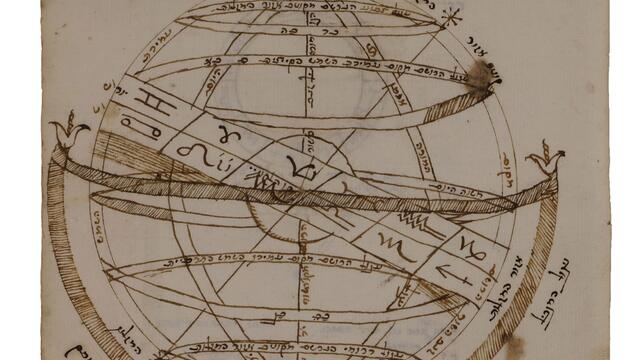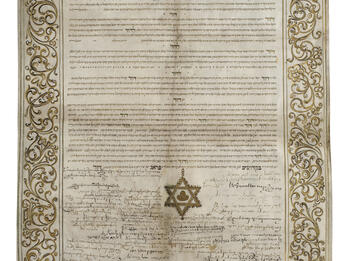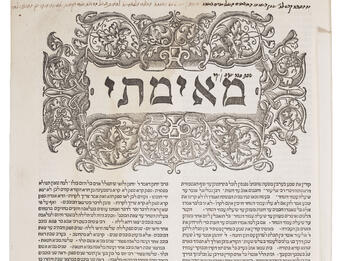Education and Scholarship, 1500–1750
The early modern period featured educational reforms, anti-Christian polemics, and growing Jewish university participation.

Significant differences in educational methods emerged in the late Middle Ages between Ashkenazic and Sephardic Jews in their various diasporas, and between both the former and the Jews of Italy. These differences became sharper in the early modern period. For the Jews of Germany and Poland in the sixteenth and seventeenth centuries, the primary goal of education was to produce children who knew their Bible and rabbinic law, and were meticulous in the observance of the commandments. While Sephardic and Italian Jews strove for these goals, they also sought to offer their young people access to the sciences. Hence, they saw to it that their children learned arithmetic, they encouraged young men to study medicine and astronomy, and they supported study of the language of their country. Educational opportunities were also beginning to open up for some Jews; quite a few Jews—mainly from Italy but also from other countries—were studying medicine at the University of Padua. In the 1560s, David Provenzalo of Mantua took up the idea of establishing a Hebrew academy, where both Jewish and general studies would be taught. The letter he wrote with his son Abraham in 1564 was sent to the Jewish communities of Italy, in hopes of attracting Jewish students who would study Torah and science in an entirely Jewish institution.
The Sephardic and Italian Jews particularly emphasized study of the Hebrew language and its grammar, and they outdid the Jews of Ashkenaz and Poland in knowledge of the Bible. This trend grew stronger following the burning of the Talmud during the 1550s, in Italy, initiated by the pope. According to a seventeenth-century Italian rabbi, Judah Asael Mehatov (Del Bene): “Because of this, there is leisure during the day and free time to be diligent in the study of the holy scriptures and the grammar of the language.”
At that time, prominent rabbis in Ashkenaz and Poland voiced harsh criticism of the state of education. Ḥayim ben Bezalel, the brother of Judah Loew (the Maharal of Prague), decried the low educational level of the teachers, who could not explain the words of the Bible and whose knowledge of Hebrew grammar was weak. Criticism no less severe was voiced against ignorance of the Bible, even among rabbis. The Mishnah was hardly taught. Pupils went from study of the Pentateuch with Rashi’s commentary directly to the study of Talmud, without their teachers taking into account their ability to understand the complex arguments of the talmudic text. Along with the flaws in the curriculum, there were flaws in the school system; a single teacher had to deal with boys of different ages studying different topics. The heder (elementary school) was private; the teacher received a salary from parents and not the community treasury. If the teacher did not attract enough children of a single age, which happened frequently, he accepted children of different ages.
In contrast, the educational institutions of the Sephardic Jews in Amsterdam, Salonika, and Hamburg were in very good shape, thanks to their excellent organization and well-planned, rational curriculum. Visitors from Poland and Germany who passed through Amsterdam expressed astonishment at the good order that prevailed in the educational institutions of the Sephardic community, in which the classes were divided by the age of the pupils, and at the systematic curriculum.
In response to this situation, several major Ashkenazic rabbis proposed reforms in the curriculum. Judah Loew was a leader in these calls for reform, and the city of Prague was their center in the second half of the sixteenth century. Judah Loew’s brother Ḥayim was drawn in, as were Ephraim Solomon Luntshitz and Isaiah Horowitz. The reforms sought to systematize the study of the Bible, the Mishnah, and the Talmud. First, the Bible was to be taught on the basis of the literal meaning of the words. When a child had some understanding, he was to be introduced to the essential laws found in the Bible. Next, the child was to study Mishnah. Only after he was familiar with the six orders of the Mishnah was he to begin studying Talmud. Similarly, students were not to study Talmud until they had mastered the Bible. And once they began Talmud study, they were not to waste their time in logic-chopping and disputes.
Polemics against Christianity
Following the rise of Protestantism and the Counter-Reformation, it became necessary to respond to new theological attacks against the Jews. Joseph of Rosheim was among the few Jews of Germany who replied to the attacks of Martin Luther and his followers. In Italy, Leone Modena wrote penetrating polemics against Christianity in his Hebrew work Magen ve-tsina (Shield and Bulwark). In the Sephardic communities of Western Europe, polemics against Christianity were a distinguishing feature of the New Christians who had returned to Judaism and sought to reestablish their Jewish identity. Their writings against Christianity, in Spanish and Portuguese, were not printed, for fear of censorship, but they were frequently copied by hand and widely circulated.
Challenges to Rabbinic Judaism
The early modern period bore witness to extensive intellectual ferment in Jewish society in Western Europe. A work by Azariah de’ Rossi, Me’or ‘enayim (Light of the Eyes), aroused strong opposition because of his critique of traditional Jewish chronology and his critical approach to the legends of the Talmud. Both Sephardic and Askhenazic scholars, such as Joseph Karo and Judah Loew, attacked his book.
Among the Sephardim in Western Europe, criticism was heard against the Oral Law and the beliefs of the sages. One well-known critic was Uriel da Costa, a New Christian who returned to Judaism and was excommunicated in Amsterdam because of his reservations about rabbinic tradition. During the seventeenth century, certain Sephardim in Amsterdam and London showed particular interest in the Karaites’ objections to the Talmud. The harshest critic of Judaism was Baruch Spinoza, who was raised in the Sephardic community of Amsterdam and came into conflict with the rabbinic establishment because of his radical philosophical critique of the Bible and of the beliefs of the rabbinic sages. He was not alone in his criticism, for his excommunication was preceded by that of the former New Christian Juan de Prado, a physician connected with him. The ḥakham (rabbi) of the Sephardic community in London, David Nieto, argued against these heterodox trends in his work Mateh Dan (The Tribe of Dan).
Other Scholarly Developments
Other changes came to characterize the intellectual style of Jewish scholars, especially in Italy but also in Amsterdam and Hamburg. Paraphrasing the biblical text in verse had been popular since the Middle Ages; in this period, too, we find renditions of Psalms into Hebrew verse, or the book of Daniel in Judeo-Persian. Biblical exegesis and commentaries on the Mishnah and Talmud continued to be written in traditional forms but with new insights. In addition, there began to be new types of and approaches to the study of ancient texts, such as the critical analysis of the Masoretic notes to the Hebrew Bible and the composition of encyclopedic anthologies of rabbinic, scientific, and medical knowledge. Jews desired to study in universities, especially medicine, and attended such Christian institutions of advanced learning as the University of Padua and the University of Leiden. Their education reverberated in the Jewish world. They wrote scientific, philosophical, and medical treatises in Latin, Spanish, and Italian—finding readers in the non-Jewish world—as well as in Hebrew.




![M10 622 Manuscript, probably from Ukraine]. Manuscript probably from Ukraine, c. 1740 with a broad collection of practical kabbalah and mystical magic. Facing page manuscript arranged vertically with Hebrew text in the shape of a figure wielding two long objects.](/system/files/styles/entry_card_sm_1x/private/images/vol05/Posen5_blackandwhite166_color.jpg?h=cec7b3c9&itok=Sz6u21MQ)